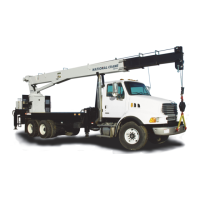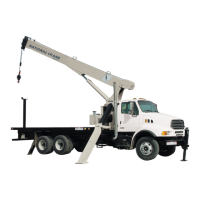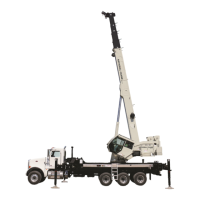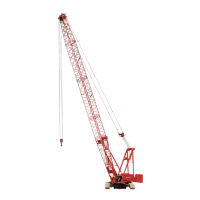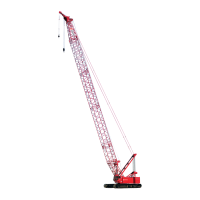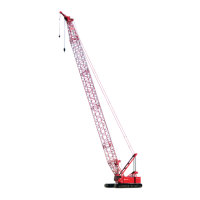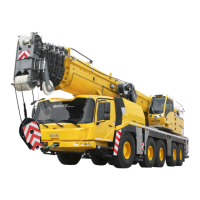MAINTENANCE 1400H OPERATOR AND SERVICE MANUAL
3-4 Published 10-30-2014 Control # 040-09
Inspection
All hoist cable in service needs to be inspected on a daily,
monthly, and quarterly basis. Cable which has been idle for a
period of a month or more must be given a thorough
inspection before it is placed in service. These inspections
should cover all types of deterioration including:
• Distortion such as kinking, crushing, un-stranding, bird
caging, main strand displacement or core protrusion.
• Loss of cable diameter in a short cable length or
unevenness of outer strands indicates the cable needs
to be replaced.
• Significant corrosion.
• Broken or cut strands.
• Number, distribution and type of visible broken wires.
• Core failure in rotation resistant ropes.
• Prior electrical contact with a power line or other electric
arc damage.
• Significantly corroded, cracked, bent, or worn end
connections.
Only inspect the outer surface of a cable. Never attempt to
open the cable.
Pay particular attention to areas of the rope where wear and
other damage is likely to occur:
• Pick-up Points: Sections of wire rope that are repeatedly
stressed during each lift, such as those sections in
contact with sheaves.
• End Attachments: The point where a fitting is attached to
the wire rope or the point where the wire rope is attached
to the hoist drum.
• Abuse Points: The point where the wire rope is
subjected to abnormal scuffing and scraping.
Daily Inspections
All cable in continuous service must be inspected at the
beginning of each work day. Inspect the eye end and length
of cable that is used in daily operation. The end should be
inspected for abrasion, corrosion, broken wires, and loose or
broken servings. Inspect the remainder of the cable length
used for daily operations for points showing kinks, sharp
bends, or any other evidences of damage or excessive wear.
Monthly Inspections
Inspect the eye end and length of cable normally used in
daily operations. Examine the rest of the cable for kinked,
crushed or otherwise damaged points.
Periodic Inspections
Wire rope should be inspected periodically/annually, or at a
shorter time interval, if necessitated by environmental or
other adverse conditions, and shall cover the entire length of
the wire rope. Periodic inspection should include all previous
items listed under Inspection, plus the following:
• Inspect for severely corroded or broken wires at end
connections.
• Inspect wire rope in areas subjected to rapid
deterioration such as:
- Sections in contact with saddles, equalizer sheaves,
or other sheaves where wire rope travel is limited.
- Sections of wire rope at or near terminal ends where
corroded or broken wires may protrude.
• Inspect boom nose sheaves, hook block sheaves, boom
extension/extension sheaves, auxiliary boom nose
sheaves, and hoist drums for wear. Damaged sheaves
or hoist drums can accelerate wear and cause rapid
deterioration of the wire rope.
Inspect the eye end of the cable for greater wear than the
rest of the cable. If the cable is in good condition, reverse the
cable on the drum so that the wear is equalized along the
total length of the cable.
Wire Rope Replacement
It is difficult to determine the exact time for replacement of
wire rope (hoist cable) since many variable factors are
involved. Proper determination of the condition of a rope
depends upon the judgment of an experienced person. The
following reasons are sufficient for consideration of rope
replacement:
• Six randomly distributed broken wires in one rope lay or
three broken wires in one strand in one lay. The rope is
unsafe for further use if there are either three broken
wires in one strand (Breaks 2, 3, 4) or a total of six
broken wires in all strands in any one lay.
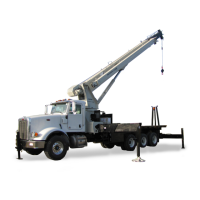
